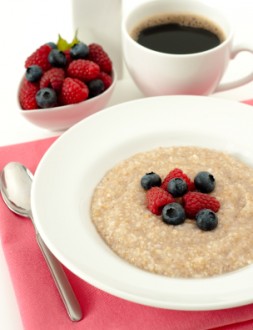The Truth about Carbs
09.27.10
Survived a spin class lately? Thank a carbohydrate. The diet industry may have you convinced that consuming carbohydrates (carbs) will have you tipping the scales, but eliminating these essential nutrients from your diet is not only unhealthy, it is unnecessary. Carbs are not your body’s enemy. They are its primary source of energy, fueling your brain, heart, lungs, immune system, as well as physical activity.
Instead of severely limiting carbs in your diet, pay closer attention to your overall caloric intake. Consuming more calories than your body requires — regardless of the source of those calories — will prevent you from reaching your ideal body weight. Following a healthy diet, about half of your daily caloric intake should come from carbohydrates, which include sugars, fibers and starches. Every carbohydrate has four calories per gram. However, all carbs are not created equal, nutritionally speaking. Candy, sodas and pastries are rich in carbs but have little to no nutritional value.
Healthy carbs contain higher amounts of fiber, vitamins, minerals and antioxidants, which lessen the risk of diabetes, heart disease and some cancers, among other illnesses. Food that is high in fiber also takes longer to digest, which makes you feel full longer. This reduces your urge to eat and prolongs your energy level. As with any food, eating an appropriate portion size is critical. Spreading your daily carb consumption throughout three small meals and one to three snacks will keep your body energized.
Are you worried about gaining weight? Toss a few of these healthy carbs into your grocery cart without feeling guilty:
Fruits: Apples, Cherries, Grapes, Oranges, Peaches, Blueberries
- A serving is one small piece of fruit or one cup of berries or melon.
- Consume one serving at a time three to four times a day.
- Eat it, don’t drink it. Whole fruit has more fiber and fewer calories than fruit juice.
- The natural sugar tames your sweet tooth, reducing cravings.
Non-Starchy Vegetables: Leafy Greens, Peppers, Broccoli, Carrots, Beets, Asparagus, Tomatoes
- A serving is ½ cup cooked or one cup raw.
- Consume three to five servings a day, or even more.
- Search for a variety of colors, including dark green, orange, yellow, purple and red.
- Try eating a salad at the end of a meal to lessen the desire for a second helping of high-calorie foods.
Starchy Vegetables: Corn, Potatoes, Green Peas, Winter Squash (Acorn, Butternut)
- Single serving: ½ cup, small ear of corn, three-inch potato
- Eat one to two servings at a time, spaced well throughout the day.
Beans and Lentils: Black Beans, Kidney Beans, Chick Peas, Black-eyed Peas
- A single serving is a ½ cup.
- Eat three to five servings a week.
- A great source of protein
Whole Grains: Bread, Cereal, Pasta, Rice
- One serving is one slice of bread or ½ cup of rice, pasta or cereal.
- Eat three to five servings a day.
- Whole grain should be the first ingredient listed on the ingredient list.
- Watch out for “multi-grain” or “honey wheat” products, which may not contain whole grains.
- There should be at least three grams of fiber per serving.
Milk:
- One serving is one cup of milk or “light” yogurt.
- Consume two to three servings per day.
- Skim or one-percent milk is low in fat and contains only 80 to 100 calories. Plus, it is loaded with nutrients, such as vitamin D, calcium, magnesium and potassium.
- If you have trouble digesting milk, try lactose-free or soy milk.
And here’s one last tip: carbohydrates are a source of energy and contribute to your body’s overall health.
Written by: Ann Whitaker, RD, LD, CDE, Kaiser Permanente of Georgia







